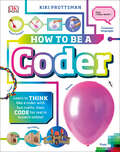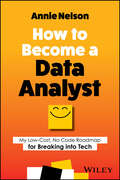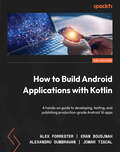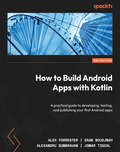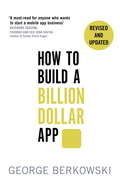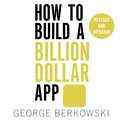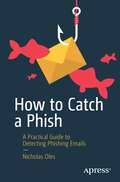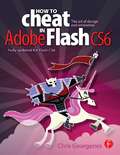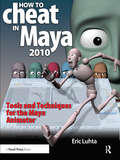- Table View
- List View
How to Be a Coder: Learn to Think like a Coder with Fun Activities, then Code in Scratch 3.0 Online (Careers for Kids)
by Kiki ProttsmanLearn to think like a coder without a computer! Each of the fun craft activities included in this book will teach you about a key concept of computer programming and can be done completely offline. Then you can put your skills into practice by trying out the simple programs provided in the online, child-friendly computer language Scratch.This crafty coding book breaks down the principles of coding into bite-sized chunks that will get you thinking like a computer scientist in no time. Learn about loops by making a friendship bracelet, find out about programming by planning a scavenger hunt, and discover how functions work with paper fortune tellers. Children can then use their new knowledge to code for real by following the clear instructions to build programs in Scratch 3.0.Perfect for kids aged 7-9, the various STEAM activities will help teach children the crucial skills of logical thinking that will give them a head-start for when they begin programming on a computer. Famous scientist pages teach children about coding pioneers, such as Alan Turing and Katherine Johnson, and topic pages, such as the Internet, give kids a wider understanding of the subject.Written by computer science expert Kiki Prottsman, How to be a Coder is so much fun kids won't realize they're learning!
How to Be a Successful Online Student
by Sara Dulaney GilbertAccording to the National Center for Education Statistics more than 85% of public universities offer non-residential long-distance learning and courses, degrees, or career credentials.
How to Beat the Market Makers at Their Own Game
by Fausto PuglieseThe basic skills for becoming a successful trader from a master of the gameWritten by Fausto Pugliese (founder and CEO of Cyber Trading University) this must-have resource offers a hands-on guide to learning the ins and outs of active trading. How to Beat the Market Makers at Their Own Game gives professionals, as well as those relatively new to investing, a behind-the-scenes look at the inner workings of the marketplace and a comprehensive overview of basic trading techniques. The book explains how to apply the trading strategies of acclaimed trader Fausto Pugliese. Step by step the author covers the most common market maker setups, shows how to identify market maker traps, and most importantly, reveals how to follow the direction of the lead market maker in an individual stock.Throughout the book, Pugliese puts the spotlight on Level II quotes to help investors understand how market makers drive prices and manipulate the market. This handy resource is filled with the tools needed to interpret market maker activity so traders can truly understand the market and trade accordingly.Offers an accessible guide for developing the investing skills to trade with confidenceFilled with the real-world trading experiences and techniques of Fausto PuglieseCovers simple technical patterns that are important in day tradingIncludes a website with exercises to help master the book's techniquesHow to Beat the Market Makers at their Own Game will become your well-thumbed resource for learning what it takes to succeed in short-term stock trading.
How to Become a Data Analyst: My Low-Cost, No Code Roadmap for Breaking into Tech
by Annie NelsonStart a brand-new career in data analytics with no-nonsense advice from a self-taught data analytics consultant In How to Become a Data Analyst: My Low-Cost, No Code Roadmap for Breaking into Tech, data analyst and analytics consultant Annie Nelson walks you through how she took the reins and made a dramatic career change to unlock new levels of career fulfilment and enjoyment. In the book, she talks about the adaptability, curiosity, and persistence you’ll need to break free from the 9-5 grind and how data analytics—with its wide variety of skills, roles, and options—is the perfect field for people looking to refresh their careers. Annie offers practical and approachable data portfolio-building advice to help you create one that’s manageable for an entry-level professional but will still catch the eye of employers and clients. You’ll also find: Deep dives into the learning journey required to step into a data analytics role Ways to avoid getting lost in the maze of online courses and certifications you can find online—while still obtaining the skills you need to be competitive Explorations of the highs and lows of Annie’s career-change journey and job search—including what was hard, what was easy, what worked well, and what didn’t Strategies for using ChatGPT to help you in your job searchA must-read roadmap to a brand-new and exciting career in data analytics, How to Become a Data Analyst is the hands-on tutorial that shows you exactly how to succeed.
How to Become a Video Game Artist: The Insider's Guide to Landing a Job in the Gaming World
by Sam R. KennedyBecome a Player in the Business of Video Game ArtEvery year video games generate billions of dollars and some of the most dynamic and engaging artwork today. It's an ever-growing field that holds great professional opportunity, but you need the right skills and savvy if you want to stake your claim. In How to Become a Video Game Artist, veteran video game designer Sam R. Kennedy provides the inside track on everything you need to forge a career in the world of video game art. Starting with the basics of game creation and a look at the artistic skills necessary to get started, Kennedy spotlights specific, key roles for creators--from concept artists to character animators to marketing artists and beyond. Each chapter features screenshots from popular video games like Tom Clancy's Ghost Recon and World of Warcraft; interviews with video game art professionals who've worked for top gaming companies like BioWare, Blizzard, and Ubisoft; step-by-step examples of actual game art; and detailed breakdowns of the training and portfolio samples you'll need to make these jobs your own. For anyone who wants to go from gamer to game designer, this book contains all the secrets you'll need to rise to the top of one of the most exciting industries of our time.
How to Build Android Applications with Kotlin: A hands-on guide to developing, testing, and publishing production-grade Android 16 apps
by Eran Boudjnah Alex Forrester Alexandru Dumbravan Jomar TigcalUtilize Android programming to build scalable and reliable apps using industry best practices with practical guidance from a team of Android experts with over 40 years of combined experience Get a free PDF copy, AI Assistant, and Next-Gen Reader with your bookKey FeaturesBuild real-world Android apps with Kotlin and the Jetpack Compose UI frameworkLeverage the latest libraries to accelerate your Android developmentOvercome development challenges with tips and tricks from experienced Android professionalsGet With Your Book: PDF Copy, AI Assistant, and Next-Gen Reader FreeBook DescriptionWritten by four veteran developers with 60+ years of collective experience, this updated third edition will jumpstart your Android development journey, focusing on Kotlin libraries and Jetpack Compose, Google’s powerful declarative UI framework. You’ll learn the fundamentals of app development, enabling you to use Android Studio, as well as get to grips with Jetpack Compose to create your first screens, build apps to run them on virtual devices through guided exercises, and implement Jetpack Compose’s layout groups to make the most of lists, images, and maps. The book has been updated with Kotlin’s powerful networking and coroutines libraries to help you fetch data in the background from a web service and manage displaying the data using Kotlin flows. You’ll learn about testing, creating clean architecture, and persisting data, as well as exploring the dependency injection pattern and learning how to publish your apps on the Google Play Store. You'll also work on realistic projects split up into bite-size exercises and activities, along with building apps to create quizzes, read news articles, check weather reports, store recipes, retrieve movie information, and remind you where you parked your car. By the end of this book, you'll have gained the skills and confidence to build your own creative Android apps using Kotlin.What you will learnCreate maintainable and scalable apps using KotlinGrasp Android asynchronous programming with coroutines and the Flow APISimplify app development with Google architecture componentsApply MVVM and Repository architecture patterns to standardize retrieving and displaying data from outside sourcesIncrease app stability and robustness with unit and integration testsUse standard libraries for dependency injection, networking, data parsing, and persistencePublish your app on the Google Play StoreWho this book is forThis book is for beginners as well as intermediate-level developers with no prior experience in Android app development. Basic knowledge of the Kotlin programming language or experience in a similar programming language, along with a willingness to brush up on Kotlin is required.
How to Build Android Apps with Kotlin: A practical guide to developing, testing, and publishing your first Android apps
by Alex Forrester Eran Boudjnah Alexandru Dumbravan Jomar TigcalUnleash the power of Android programming to build scalable and reliable apps using industry best practices Purchase of the print or Kindle book includes a free PDF eBookKey FeaturesBuild apps with Kotlin, Google’s preferred programming language for Android developmentUnlock solutions to development challenges with guidance from experienced Android professionalsImprove your apps by adding valuable features that make use of advanced functionalityBook DescriptionLooking to kick-start your app development journey with Android 13, but don’t know where to start? How to Build Android Apps with Kotlin is a comprehensive guide that will help jump-start your Android development practice. This book starts with the fundamentals of app development, enabling you to utilize Android Studio and Kotlin to get started with building Android projects. You'll learn how to create apps and run them on virtual devices through guided exercises. Progressing through the chapters, you'll delve into Android's RecyclerView to make the most of lists, images, and maps, and see how to fetch data from a web service. You'll also get to grips with testing, learning how to keep your architecture clean, understanding how to persist data, and gaining basic knowledge of the dependency injection pattern. Finally, you'll see how to publish your apps on the Google Play store. You'll work on realistic projects that are split up into bitesize exercises and activities, allowing you to challenge yourself in an enjoyable and attainable way. You'll build apps to create quizzes, read news articles, check weather reports, store recipes, retrieve movie information, and remind you where you parked your car. By the end of this book, you'll have the skills and confidence to build your own creative Android applications using Kotlin.What you will learnCreate maintainable and scalable apps using KotlinUnderstand the Android app development lifecycleSimplify app development with Google architecture componentsUse standard libraries for dependency injection and data parsingApply the repository pattern to retrieve data from outside sourcesBuild user interfaces using Jetpack ComposeExplore Android asynchronous programming with Coroutines and the Flow APIPublish your app on the Google Play storeWho this book is forIf you want to build Android applications using Kotlin but are unsure of how and where to begin, then this book is for you. To easily grasp the concepts in this book, a basic understanding of Kotlin, or experience in a similar programming language is a must.
How to Build Android Apps with Kotlin: A practical guide to developing, testing, and publishing your first Android apps, 2nd Edition
by Eran Boudjnah Alex Forrester Alexandru Dumbravan Jomar TigcalUnleash the power of Android programming to build scalable and reliable apps using industry best practicesPurchase of the print or Kindle book includes a free PDF eBookKey FeaturesBuild apps with Kotlin, Google's preferred programming language for Android developmentUnlock solutions to development challenges with guidance from experienced Android professionalsImprove your apps by adding valuable features that make use of advanced functionalityBook DescriptionLooking to kick-start your app development journey with Android 13, but don't know where to start? How to Build Android Apps with Kotlin is a comprehensive guide that will help jump-start your Android development practice. This book starts with the fundamentals of app development, enabling you to utilize Android Studio and Kotlin to get started with building Android projects. You'll learn how to create apps and run them on virtual devices through guided exercises. Progressing through the chapters, you'll delve into Android's RecyclerView to make the most of lists, images, and maps, and see how to fetch data from a web service. You'll also get to grips with testing, learning how to keep your architecture clean, understanding how to persist data, and gaining basic knowledge of the dependency injection pattern. Finally, you'll see how to publish your apps on the Google Play store. You'll work on realistic projects that are split up into bitesize exercises and activities, allowing you to challenge yourself in an enjoyable and attainable way. You'll build apps to create quizzes, read news articles, check weather reports, store recipes, retrieve movie information, and remind you where you parked your car. By the end of this book, you'll have the skills and confidence to build your own creative Android applications using Kotlin.What you will learnCreate maintainable and scalable apps using KotlinUnderstand the Android app development lifecycleSimplify app development with Google architecture componentsUse standard libraries for dependency injection and data parsingApply the repository pattern to retrieve data from outside sourcesBuild user interfaces using Jetpack ComposeExplore Android asynchronous programming with Coroutines and the Flow APIPublish your app on the Google Play storeWho this book is forIf you want to build Android applications using Kotlin but are unsure of how and where to begin, then this book is for you. To easily grasp the concepts in this book, a basic understanding of Kotlin, or experience in a similar programming language is a must.
How to Build a Beowulf: A Guide to the Implementation and Application of PC Clusters
by Thomas L. Sterling John Salmon Donald J. Becker Daniel F. SavareseSupercomputing research--the goal of which is to make computers that are ever faster and more powerful--has been at the cutting edge of computer technology since the early 1960s. Until recently, research cost in the millions of dollars, and many of the companies that originally made supercomputers are now out of business. The early supercomputers used distributed computing and parallel processing to link processors together in a single machine, often called a mainframe. Exploiting the same technology, researchers are now using off-the-shelf PCs to produce computers with supercomputer performance. It is now possible to make a supercomputer for less than $40,000. Given this new affordability, a number of universities and research laboratories are experimenting with installing such Beowulf-type systems in their facilities. This how-to guide provides step-by-step instructions for building a Beowulf-type computer, including the physical elements that make up a clustered PC computing system, the software required (most of which is freely available), and insights on how to organize the code to exploit parallelism. The book also includes a list of potential pitfalls.
How to Build a Billion Dollar App: Discover the secrets of the most successful entrepreneurs of our time
by George BerkowskiTHE ULTIMATE GUIDE TO BUILDING AN APP-BASED BUSINESS 'A must read for anyone who wants to start a mobile app business' Riccardo Zacconi, founder and CEO King Digital (maker of Candy Crush Saga) 'A fascinating deep dive into the world of billion-dollar apps. Essential reading for anyone trying to build the next must-have app' Michael Acton Smith, Founder and CEO, Mind Candy Apps have changed the way we communicate, shop, play, interact and travel and their phenomenal popularity has presented possibly the biggest business opportunity in history.In How to Build a Billion Dollar App, serial tech entrepreneur George Berkowski gives you exclusive access to the secrets behind the success of the select group of apps that have achieved billion-dollar success.Berkowski draws exclusively on the inside stories of the billion-dollar app club members, including Instagram, Whatsapp, Snapchat, Candy Crush and Uber to provide all the information you need to create your own spectacularly successful mobile business. He guides you through each step, from an idea scribbled on the back of an envelope, through to finding a cofounder, building a team, attracting (and keeping) millions of users, all the way through to juggling the pressures of being CEO of a billion-dollar company (and still staying ahead of the competition).If you've ever dreamed of quitting your nine to five job to launch your own company, you're a gifted developer, seasoned entrepreneur or just intrigued by mobile technology, How to Build a Billion Dollar App will show you what it really takes to create your own billion-dollar, mobile business.
How to Build a Billion Dollar App: Discover the secrets of the most successful entrepreneurs of our time
by George BerkowskiTHE ULTIMATE GUIDE TO BUILDING AN APP-BASED BUSINESS 'A must read for anyone who wants to start a mobile app business' Riccardo Zacconi, founder and CEO King Digital (maker of Candy Crush Saga) 'A fascinating deep dive into the world of billion-dollar apps. Essential reading for anyone trying to build the next must-have app' Michael Acton Smith, Founder and CEO, Mind Candy Apps have changed the way we communicate, shop, play, interact and travel and their phenomenal popularity has presented possibly the biggest business opportunity in history.In How to Build a Billion Dollar App, serial tech entrepreneur George Berkowski gives you exclusive access to the secrets behind the success of the select group of apps that have achieved billion-dollar success.Berkowski draws exclusively on the inside stories of the billion-dollar app club members, including Instagram, Whatsapp, Snapchat, Candy Crush and Uber to provide all the information you need to create your own spectacularly successful mobile business. He guides you through each step, from an idea scribbled on the back of an envelope, through to finding a cofounder, building a team, attracting (and keeping) millions of users, all the way through to juggling the pressures of being CEO of a billion-dollar company (and still staying ahead of the competition).If you've ever dreamed of quitting your nine to five job to launch your own company, you're a gifted developer, seasoned entrepreneur or just intrigued by mobile technology, How to Build a Billion Dollar App will show you what it really takes to create your own billion-dollar, mobile business.
How to Buy, Sell, and Profit on eBay
by Adam GinsbergA lively insider's guide to starting a successful small business selling items old and new on eBay, written with personal anecdotes, well-kept secrets, and insider tips by Adam Ginsberg, eBay's most successful private salesperson. This is the insider's guide to making money on eBay. Adam Ginsberg is the most successful seller on eBay, moving around a million dollars' worth of merchandise every month. Not only will he impart his personal secrets on how to sell on eBay -learned through years of experience - and his tips on expanding your small business using eBay as a global market, but he'll also give fun side-notes and anecdotes, keeping the book lively and making it a fun and interesting read. This book will be a must-have for all current and aspiring eBay sellers, all small-business owners, and anyone who wants to learn how to start a million-dollar company.
How to Catch a Phish: A Practical Guide to Detecting Phishing Emails
by Nicholas OlesLearn how to detect, analyze, and respond to phishing emails, the top infection vector used by cybercriminals. The repeatable process described in this book has been cultivated and tested in real-life incidents and validated across multiple threat landscapes and environments.Every organization and individual with an email account is susceptible to deceptive emails sent by attackers with nefarious intentions. This activity, known as phishing, involves an attacker attempting to lure individuals into providing sensitive information or performing a predetermined action. Attacks vary in sophistication, but the core skills and process to detect, analyze, and respond to a suspicious message does not change. Attackers have preyed on victims with convincing and not-so-convincing phishing emails to gain initial footholds into networks around the world for over 30 years. This attack method has been rapidly growing in popularity and continues to be the number one method that organizations and individuals struggle to defend against. Regardless of what any vendor or organization will tell you, no infallible tool exists to eliminate this threat completely. This book teaches you how to analyze suspicious messages using free tools and resources. You will understand the basics of email, tactics used by attackers, and a repeatable process to systematically analyze messages and respond to suspicious activity.You Will Learn How to: Safely save email messages as attachments for analysisIdentify what information is in an email headerReview header information and extract key indicators or patterns used for detectionIdentify signs of a suspicious or malicious email messageDetect the tactics that attackers use in phishing emailsSafely examine email links and attachmentsUse a variety of free and simple tools to analyze email messages Who This Book Is For Cybersecurity professionals and interested computer security enthusiasts currently holding or aspiring to obtain positions such as IT Security Analyst, Network Defender, Security Operations Center Analyst, or Help Desk Technician. Readers should have a general understanding of how email works and some ways that attackers use this platform for initial access.
How to Cheat in 3ds Max 2011: Get Spectacular Results Fast
by Michele Bousquet**How to Cheat in 3ds Max - updated for latest rev of Max**Need to get results with 3ds max fast? Why take months to learn every button in 3ds max when you can create great visuals with just a few key tools? Learn to create quick yet stunning special effects, and animated characters with the fastest techniques possible. Need convincing grass, trees, water, shadows? You can use the memory-hogging methods that choke your display and take forever to render, or you can get it done bing-bang with this book. When you need an animated character you can spend days fiddling with polygons, or you can use this book to put it together in minutes and get the entire project done in a day. How to Cheat in 3ds max includes a host of time-saving techniques as well as little-known tools that will make you look like an expert in no time flat. This book is for busy professionals who need to get it done right, but also need it done fast. This rev of the book will have higher-end cheats (for Intermediate users) and ALL NEW or UPDATED content on: new modelling and material tools, mental ray, special effects, particle systems, and scripting. The web site offers scene files and bitmaps used to illustrate the cheats, also music files, organizational samples, and instructional Camtasia movies of Michele where Michele showing some of the trickier techniques.
How to Cheat in 3ds Max 2014: Get Spectacular Results Fast
by Michael McCarthyWhy take months to learn every button in 3ds Max when you can create great visuals with just a few key tools? Utilize the tool of choice, 3ds Max 2014, for generating realistic environments, seamless CG effects, and jaw dropping games in a matter of hours. You can use the memory-hogging methods that choke your display and take forever to render, or you can get it done quickly and efficiently. Michael McCarthy offers a goldmine of artistic inspiration, timesaving tips & tricks, and step-by-step walkthroughs—you’ll wonder how you every got by without it! Start animating today with detailed tutorials, source files, bitmaps, and video demonstrations—all featured on the companion website. This new edition has been completely revamped for 3ds Max 2014. You will find coverage on brand new features and tools such as Scene Management, iRay, Nitrous, Mass FX, and particles and physics. How to Cheat in 3ds Max 2014 features interviews with industry professionals that will help you gain the edge you need in the competitive world of animation. 3ds Max luminary and recipient of the 2011 Autodesk 3ds Max Master Award, author Michael McCarthy shares his 3ds Max secrets and little-known tips and tricks that save users hours of time Includes all new content and advanced cheats on modelling, special effects, natural elements, and the particle system Proven How to Cheat series teaches how to create quick yet stunning special effects, animations, realistic textures, and game elements
How to Cheat in 3ds Max 2015: Get Spectacular Results Fast (How To Cheat)
by Michael McCarthyWhy take months to learn every button in 3ds Max when you can create great visuals with just a few key tools? Utilize the tool of choice, 3ds Max 2015, for generating realistic environments, seamless CG effects, and jaw dropping games in a matter of hours. You can use the memory-hogging methods that choke your display and take forever to render, or you can get it done quickly and efficiently. <P><P> Michael McCarthy offers a goldmine of artistic inspiration, timesaving tips & tricks, and step-by-step walkthroughs—you’ll wonder how you every got by without it! This new edition has been completely revamped for 3ds Max 2015. Start animating today with detailed tutorials, source files, bitmaps, and video demonstrations—all featured on the companion website.
How to Cheat in Adobe Animate CC (How To Cheat)
by Myra Ferguson Chris GeorgenesWould you rather take months to learn every tool, every feature, and every concept in Adobe Animate or start right now making your own creations with just a few steps? Myra Ferguson is teaming up with Chris Georgenes to help you create great animation, bring objects to life with cool motion effects, and enhance your productivity in Animate CC! How to Cheat in Adobe Animate CC is a goldmine of artistic inspiration, time-saving practical tips, and step-by-step walkthroughs. Let your sasquatch sunbathe, your coyote howl, and your lint spider see the light of day. With real-world projects and project source files, you can follow along and try for yourself. This book includes all NEW content and cheats for Animate CC, such as making cinemagraphs, creating a double exposure effect, speeding up the process of making real life doodles, simulating a bokeh effect, converting your documents to HTML5, and more. Key Features • Glimpse into the workflow of digital media and animation experts and apply practical techniques and tips to your own projects with source files, examples, and tutorials. • Learn a myriad of tricks based on real-life working methods to help you work faster and more efficiently with new features in Adobe Animate CC and the Creative Cloud. • Work from the problem to the solution to gain the best possible results from Animate.
How to Cheat in Adobe Flash CS5: The Art of Design and Animation (How To Cheat In Ser.)
by Chris GeorgenesNeed to solve problems quickly to develop creative projects to time and to budget? Want to hone your Flash skills so you can concentrate on your animation? Then How to Cheat in Flash is for you! Chris Georgenes shows how to work from the problem to the solution - from the viewpoint of an animator who has been commissioned to create a job and is working to a deadline and to a budget. With his in-depth knowledge of the little-known secrets used by the pros to produce creative, professional animations, Chris is the go-to guru for designers and animators who want to create great animation, applications or motion design with Flash. Fully updated for CS5, How to Cheat in Flash CS5, is a goldmine of artistic inspiration, timesaving practical tips, tricks and step-by-step workthroughs that you'll wonder how you survived without it. Each techniques is designed as a double-page spread so you can prop the book up behind your keyboard or next to your monitor as a visual reference while working alongside it. Many of these workthroughs are real-world client projects, with the source files supplied for you to open and explore. With these real-life professional projects you'll discover how to: bring objects to life with cool motion effects, make it rain, snow or set your world ablaze, develop flash mobile applications and many more tips and tricks not found anywhere else!
How to Cheat in Adobe Flash CS6: The Art of Design and Animation
by Chris GeorgenesEditor's note, 1/15/2013: We have discovered an error with the Table of Contents and are currently working on correcting it. If you find an error in your book, please visit the companion site http://www.focalpress.com/books/details/9780240522500/ for the correct version. Whether you are creating an animated short, catchy and fun cartoon or mobile game, save time and money with expert cheats by renowned Flash Expert, Chris Georgenes with all new content for the Flash CS6 revision. With practical applications and step by step tutorials solve problems quickly to develop creative projects to time and to budget. Many of these walkthroughs are real-world client projects, with the source files supplied for you to open and explore. With these real-life professional projects you'll discover how to: bring objects to life with cool motion effects, make it rain, snow or set your world ablaze, develop flash mobile applications and many more tips and tricks not found anywhere else! With his in-depth knowledge of the little-known secrets used by the pros to produce creative, professional animations, Chris is the go-to guru for designers and animators who want to create great animation, applications or motion design with Flash. Fully updated for CS6, How to Cheat in Flash CS6, is a goldmine of artistic inspiration, timesaving practical tips, tricks and step-by-step walkthroughs that you'll wonder how you survived without it. New! CS6 cheats and examples with practical solutions for the busy animator with a focus on Action Script, Flash for mobile applications, specifically for Android development, as well as a focus on an improved physics engine. Put the Adobe Flash CS6 cheats to the test with the fully updated companion website with downloadable Flash source files, examples and video tutorials, and a creative commons game, developed with Adobe, to demonstrate the new functionality of CS6!
How to Cheat in Blender 2.7x (How To Cheat)
by Alan ThornBlender is a vast and customizable 3D-modeling application used by many artists across creative industries, from television to games. This newest book, in Alan Thorn’s How to Cheat series, offers insightful and bite-sized power-tips to help you develop Blender mastery. More than five hundred figures illustrate interesting shortcuts and clever ways to improve your Blender workflow. A companion website at http://www.alanthorn.net provides bonus content, including videos and resources to help sharpen your skills further. How to Cheat in Blender 2.7x is for Blender users of all levels, offering time-saving tips and powerful techniques to increase your productivity. Key Features Bite-sized tips and tricks that can be read in any order Illustrated examples and step-by-step guides for improving your workflow Explores practical applications and real-world contexts Demonstrates "lesser-known" and unconventional tips Improves your efficiency and workflow
How to Cheat in Maya 2012: Tools and Techniques for Character Animation
by Eric LuhtaThe Maya guide for animators, How to Cheat in Maya 2012 presents everything you need to know about character animation in Maya. Fully updated for the latest revision of Maya, this book provides you with complete, step-by-step walkthroughs of essential animation techniques to increase your efficiency and speed. This is an animator's workflow in book form, written by professional animators-not a software book with a few animation pointers thrown in. In addition to all the gold-mine coverage and interviews with expert animators from the previous edition, How to Cheat in Maya 2012 also features a new in-depth chapter on the principles of animation, updated information on camera settings and animation using Maya's new Camera Sequencer tool, the ins and outs of the brand new Editable Motion Trails tool, new techniques for working with characters in multi-shot animation tests and short films, a new cycles chapter covering actions like flying and walks, time-saving scripts, and advanced tricks with the new Graph Editor. The proven "How to Cheat" series gets you up to speed quickly, and in a way that's fun.
How to Cheat in Maya 2013: Tools and Techniques for Character Animation
by Kenny Roy Eric LuhtaAll professional animators know a handful of secrets that give them an edge in a production environment. "How to Cheat in Maya" puts these secrets in your hands! Learn time and energy saving techniques tested in real Hollywood productions in this book, jam-packed with screenshots and scene files designed to get you up to speed quickly. From menus to modeling, lipsync to lighting, How to Cheat in Maya 2013 covers all of the methods available in the latest version of Maya. Get up to speed quickly and produce stellar results with these insider workflows. With new, updated cheats for the latest version of Maya, "How to Cheat in Maya" is an essential guide for amateur and professional 3D animators alike. Fulyl updated with gold-mine coverage including: expanded sections on production workflow, all new chapters covering rigging cheats and Maya's referencing tools, and brand new project files demonstrating production-proven techniques. The companion website includes complete scene files for exercises and techniques, extra rigs, Quicktime movies of full projects, and video tutorials.
How to Cheat in Maya 2014: Tools and Techniques for Character Animation
by Kenny RoyAll professional animators know a handful of secrets that give them an edge in a production environment. "How to Cheat in Maya" puts these secrets in your hands! Learn time and energy-saving techniques tested in real Hollywood productions in this book, jam-packed with screenshots and scene files designed to get you up to speed quickly. <P><P>From menus to modeling, lipsync to lighting, How to Cheat in Maya 2014 covers all of the methods available in the latest version of Maya. Get up to speed quickly and produce stellar results with these insider workflows. With new, updated cheats for the latest version of Maya, How to Cheat in Maya 2014 is an essential guide for amateur and professional 3D animators alike. Fully updated with gold-mine coverage including: expanded sections on production workflow, all new chapters covering rigging cheats and Maya's referencing tools, and brand new project files demonstrating production-proven techniques. <P><P>The companion website includes complete scene files for exercises and techniques, extra rigs, Quicktime movies of full projects, and video tutorials.
How to Cheat in Maya 2017: Tools and Techniques for Character Animation (How To Cheat)
by Paul NaasThis is not a book about Maya software with a few animation pointers thrown in here and there. This is a guide to Maya software written by professional animators. This book provides you with complete, set-by-step walkthroughs of essential animation techniques that increase your speed and efficiency while using Maya 2017 for character animation. From curves to constraints, this book covers all of the methods available in the latest version of Maya. Featuring gold-mine coverage this book teaches you new techniques for working with characters in animation tests and short films. Accompanied by a companion site, this is the one and only guide to get you up to speed. <P><P>Key Features <li>Complete step-by-step, walkthroughs of essential techniques every animator needs to know. <li>Features interviews with leading experts and experienced animation leads. <li>Companion web site including all exercise/example scene files and extras such as video tutorials and animation files. <li>Interlude articles covering everything from Reference Video to Resumes.
How to Cheat in Maya: Tools and Techniques for the Maya Animator (How To Cheat In Ser.)
by Eric LuhtaTake your animations to the next level with this essential guide to Maya 2010. Packed with character animation techniques and the secrets of professional animators, How to Cheat in Maya 2010 provides the tips and tools to help you create high quality animation in the most efficient way possible. This comprehensive guide to animating with Maya contains gold-mine coverage, including animation techniques, using Maya's tools with the 12 animation principles, working with constraints, and even foolproof lighting tricks to show off your work. With this essential handbook, learn which circumstances call for which techniques, and how to get quality results fast. You will not only learn how to be productive in Maya, but also be given access under the hood to the actual scene files of a professional animator. Covering such topics such as pose to pose blocking, layered animation, fixing gimbal lock, facial animation, and much more, How to Cheat in Maya 2010 is an invaluable resource for artists and animators alike.-- See "under the hood" of a professional animator's workflow with beginning and ending scene files for every technique and workflow example in the book. --Complete, step-by-step walkthroughs of essential techniques every animator needs to know such as walk cycles, pose-to-pose blocking, lip syncing to dialogue, and much, much more.-- Proven "How to Cheat" series - Learn to create impressive, appealing animations using the fastest techniques possible, containing everything you need to know about Maya as a character animator.--Includes rarely discussed topics, such as reading spline curves, avoiding gimbal lock, animation layers, creating appealing lighting for demo reels, and features interviews with some of the most experienced animation leads and TDs working in the industry -- Learn to apply these professional techniques to your own animations with the accompanying downloadable resources which include all scene files to follow along with, as well as final versions to study in the Graph Editor
